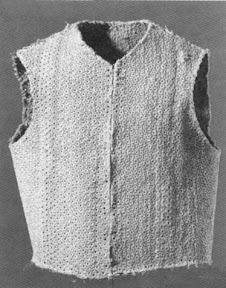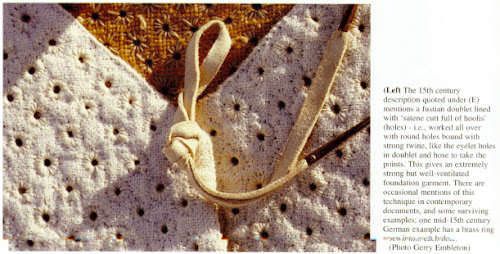Je rajoute un peu d'eau à mon propre moulin ... Voici ce que j'ai pu découvrir tout à fait par hasard ....
Et c'est d' "enfer" !!! (Cfr.
http://medievalgloves.blogspot.com/2007 ... -hell.html)
Bon, je vous l'accorde c'est en anglais .... Comme vous le découvrirez, c'est assez complet ...
Demeure une grande inconnue : la datation de cette pièce !!! ... Si l'une des éminences du forum avait une réponse concrète, ça me ferait bien plaisir ....
The Holledoublet aka doublet from hell
Yes, this is an insane project - but it's finished.
The doublet has quilted sleeves, but they are in my husband's armour bag... (Pictures will follow).
First: My husband didn't asked me to do it - it was my own idea. But he loves it. And he likes the feeling. I cannot recommend to do it as a armouring project, because it took me 2 1/2 years to do it - and I would never recommend to do such stuff!!
Secound: It's called "doublet from hell" because it's one of these "projects from hell" - time intense, work intense, suffering (got a tennis elbow from doing the quilting!!)...
Holle doublet - full view
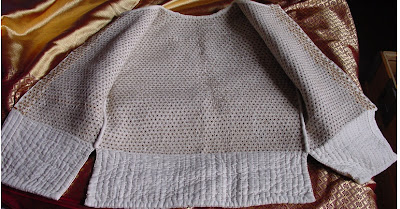
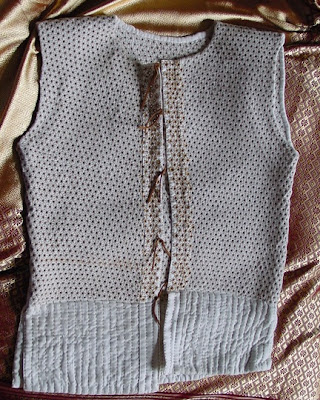
Holledoublet - details
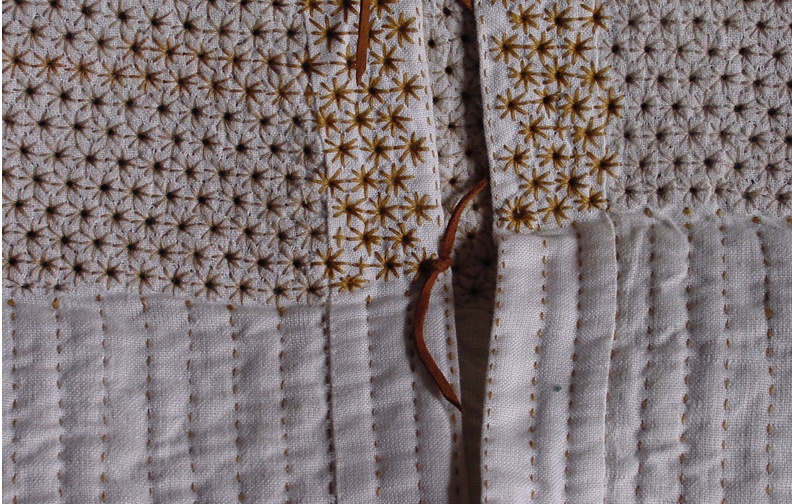 Documentation
1. What is a “holledoublet”?
Documentation
1. What is a “holledoublet”?
A “holledoublet” is a doublet “full of holes”, an “eyelet gambeson”. It is described in a mid-fifteenth English manuscript titled “how a man schall be armyd at his ese when he schal fighte on foote”:
“He schal have noo schirte up on him but a dowbelet of ffustean lyned with satene cutte full of hoolis.”[1]
Some of these fantastic gambesons have survived and can be seen in museums worldwide (Coburg, Bern, Würzburg, Brüssel and New York). The German names for this piece of armor is “Lentner”, and the fabric, which emerged from sewing the layers of linen together with eyelets, was called “Panzerstoff” (bullet proof fabric). This is the right description for this fabric, as ”the stitches touch and make a reenforcing web of threads, the eyelet holes let the air pass”.[2]
The existing pieces are hard to date, but “may have been quite common. […] Nothing can be judged about the popularity of an item by how many survive today. It is usually rarities that are treasured and preserved. Common everyday objects are usually used to death.”[3]
a.) Coburg: horseman - holledoublet, and it is preserved complete.
It is made only of linen 3 to 4 layers. The material for the holes is also linen.[4]
(sorry, no picture...)
b.)Bern: Four layers of linen with inserted rings.[5] (C'est celui qui est représenté dans le premier post !)
c.) Holledoublet for a dog/ Veste Coburg: Made from several layers of linen. This armor was used for the boar hunt – a very good example of the strength of the material! [6]
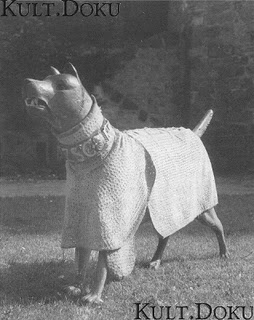 2. Materials
2. Materials
Comparing the Materials I used to the one in the Original pieces
Originals: White Linen fabric, white linen thread;
Some pieces without metall rings, but found in two pieces (Würzburg, Bern).
The piece in Würzburg has brass rings in it, but I couldn’t find out how they were manufactured. The could be made excactly like the rings for a chain mail (from a brass wire) or punched from a sheet of brass foil
My work: White Linen fabric; Linen thread – natural dyed with onion skin to make the eyelets visible (I wanted my hard work to show and liked the pattern of the little “stars”); Brass rings, modern manufactured. I decided to use modern ones, because of time (this project took me nearly two years to finish WITHOUT making the brass rings myself) and as there was no way to find out how the originals were made (museums don’t like it when you take apart your museum pieces. And there was no chance to see it through the glass or handle them)
The arms were not preserved. But if you compare them to other period gambesons “period choices of materials were usually two or more layers of linen stuffed with tow, rags or other material."[7]
Quilted arms: linen, woolen fabric, linen thread. See Maciejowski Bible for quilting pattern:[8]
As the fingings are not finished except the Coburg one, it is hard to guess which way of finish they used in period. Some of the Coburg seams are finished by folding the layers to the inside and sew the seam allowances together with a running stitch.
Linen ribbon for finishing neckline, armholes and seams
My aim was to stop any fraying from occurring. As decribed and pictured in the London finds I used a ribbon for facing.[9] I chose linen because of its strength.
3. Manufacturing process
pattern
I mesured my husband and made a pattern. I did a simple tunic shape, just slightly narrower at the hips and with shoulder seams for a better fit. I cut the parts in three layers of linen, a white one and a natural coloured one.
I sewed the shoulder seams with a running stitch and reinforced the seam by opening it and fixing it with hem-stitch.[10]
inserting rings (example)
Sewing the holes in the doublet was very time consuming. I found out that the best way to do it was inserting several rings at one time and fixing them with pins. This helped as the fabric didn’t stretched that much. I pushed the awl in the middle of the ring and then sewed around it in eight stitches.
See the example piece!!
finishing neckline and armholes with linen ribbon, side seams
I sewed the linen ribbon to the right side of the arm and neck lines, then turned it over and fixed it with hem stitches. I uses white linen thread for it.
I closed the side seams and covered the seam allowance with the linen ribbon.
quilted parts (arms and hips)
I decided on vertical quilting as I didn’t want to distract with complicated quilting designs from the eyelets. I used a linen thread that is a little darker then the one used for the eyelets.
The arms were contructed of five layers of linen and two layers of wool. First the pieces were quilted. Then the shoulder and hand seam were finished, inserting ten rings for eyelets at the shoulder to attach them to the doublet. The arm seam was closed and the seam allowances were hem-stitched to the sides of the seam.
closure
The remaining pieces have no closure. So I decided to insert rings in the attached band to strengthen it, as the main power will tear on the closure points. The closure piece was worked with linen thread (same colour as quilting) on a folded piece of linen. I inserted one length of the linen ribbon at the front seam to reinforce it.
4. Literature
http://www.companie-of-st-george.ch/ml- ... 01019.html - Discussion on Mailinglist of “Company of St. George” about the holledoublet
Die Ritter. Katalog der Burgenländischen Landesausstellung 1990 auf der Burg Güssing vom 4. Mai bis 28. Oktober 1990. Harald Prickler. Eisenstadt 1990.
Alles Jagd. Eine Kulturgeschichte. Kärntner Landesausstellung im Schloß Ferlach vom 26. April bis 26. Oktober 1997. Günther Hödl und Hartwig Pucker. Klagenfurt 1997.
Gefährlich und schön. Eine Auswahl historischer Waffen aus den Beständen der Kunstsammlung der Veste Coburg. Alfred Giebig. Coburg 1996.
Arms and Armour of the Medieval Knight. An Illustrated History of Weaponry in the Middle Ages. David Edge and John Miles Paddock. Crescent Books 1995.
http://www.medievaltymes.com/courtyard/ ... ages_4.htm - Maciejowski Bible, Leaf 4
Textiles and clothing. 1150 – 1450. Elisabeth Crowfoot, Frances Pritchard and Kay Staniland. London 2002.
Footnotes
[1] Arms and Armour p. 117
[2] G. Embleton, Company of St. George mailinglist
[3] G. Embleton, Company of St. George mailinglist
[4] Gefährlich und schön p. 256
[5] Die Ritter p. 267
[6] alles jagd...eine kulturgeschichte p 584.
[7] Arms and armour p. 57
[8] maciejowski_images_4.htm
[9] Textiles and Clothing p. 159
[10] For sewing see Textiles and Clothing pp. 156